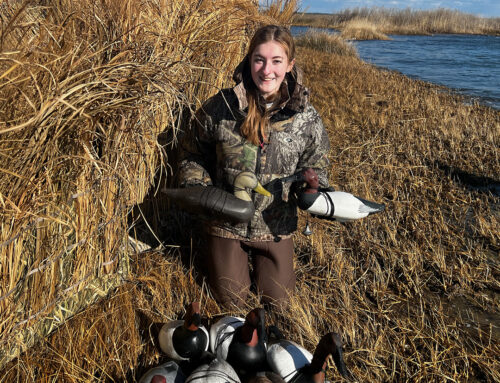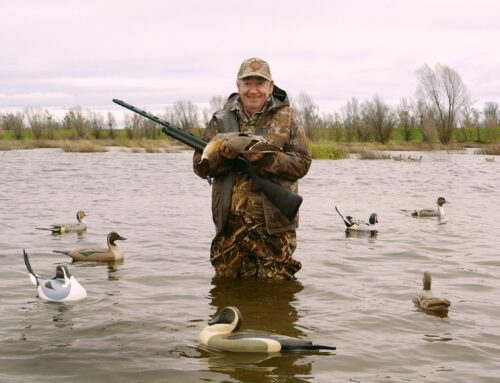Sliding Through the Cattails

Marsh skis put hidden potholes within reach of Wisconsin duck hunters
By Paul Wait
Boot-sucking bogs and head-high cattail stands don’t stop Mark Kakatsch from reaching an impossibly hidden honeyhole that is holding ducks.
The long-time Wisconsin waterfowl hunter just grabs his shotgun, stuffs his jacket with steel shotshells and straps on his skis. Then, riding on a pair of long, narrow strips of planed wood, Kakatsch glides over floating bogs and through thick vegetation that would swallow any wader-clad hunter within a few steps and snub even the most revved-up mud motor.
“Marsh skis are a little tricky to use,” Kakatsch said. “There’s definitely a bit of an art to it, and it’s a big workout to ski through the marsh. But you can get to places other hunters just can’t go.”
Most waterfowl hunters aren’t willing to take such extreme measures, even if it can lead to an amazing bounty of ducks.
As much as Kakatsch thrills at finding secret pockets of unsuspecting mallards, wood ducks and teal, he revels more in carrying on the tradition of hunting on skis. Consider this: He owns 18 pairs of marsh skis.
Uniquely Wisconsin
Although it’s uncertain who first crafted marsh skis for duck hunting, there’s little dispute that they sprang up in Wisconsin. The state’s notoriously boggy marshes make access difficult by boat, and their soft bottoms are impossible to wade. But those alluring duck holes way back in the cattails undoubtedly led an enterprising hunter from the Badger State who was also a snow skier to adapt a pair of skis for marsh use in the early 1900s.
The method caught on, and soon, other hunters were strapping long planks to their boots in pursuit of ducks.
“The heyday of marsh skis was the 1920s through the 1950s,” Kakatsch said.
Ron Koch, a noted author and decoy carver from Omro, Wisconsin, grew up hunting the Winnebago Lakes system, the likely birthplace of marsh skis.
“There were many makers in the area at one time,” he said. “I made five or six pairs back in the 1960s. When I was young, back in the 1960s and 1970s, I skied nearly every day.”
According to Koch, Ted Dorschner of Zittau, Wisconsin, made skis commercially from the 1920s to the 1950s. Dorschner and his son made about 200 pairs of marsh skis a year. Wally Marquardt of Larsen, Wisconsin, was another notable marsh ski maker.
Not surprisingly, Kakatsch owns vintage marsh skis made by both Dorschner and Marquardt.
Specialized Skis
Most of these specialized skis are made of ash, a flexible wood that can be boiled or steamed and then bent into the desired shape.
Marsh skis are long — at least 10 feet — with many up to 12 feet. The best skis have a foot or two of curl on the tips to help a hunter get through the cattails without getting stuck. Kakatsch said that without the curl, the tips of the skis would dig under the bogs or wedge into the cattails, likely sending the hunter face-first into the muck.
Most of the skis Kakatsch owns are narrow, only 5 or 6 inches wide. While a wider ski might improve balance, there’s a trade-off.
“You need to keep them narrow,” he explained. “The more surface area you have, the harder you have to work to walk on them. You have to remember that wherever you go on skis, you have to get back on them, too. It’s a workout.”
The binding is not like a snow ski. A simple loop strap is all that holds a hunter’s wader boots to the skis.
“The best binding material is a piece of firehose or innertube material that allows the hunter to slip skis on and off easily,” Kakatsch explained. “Sometimes, you need to kick them off to shoot or turn.”
Bygone Tradition?
Kakatsch started skiing for ducks in the 1980s, first at Nemahbin Lake, and then at Horicon Marsh, where he still hunts on skis today.
“My grandpa had marsh skis stored in the garage,” Kakatsch recalled. “I asked him what they were. He told me that when I got old enough, we’d go out on the skis. When I was 14 years old, he gave them to me and said, ‘There you go.’ So I put them on and went into the marsh.”
Marsh skiers generally either jump-shoot a number of small spots, or travel into a remote pothole and set a couple decoys to wait for action.
In either case, a hearty, reliable retriever is essential, according to Kakatsch.
“You need to have a good dog that can retrieve on sight and sound,” he said. “And the dog has to know not to step on the back of your skis.”
As a young hunter, Kakatsch discovered that his skis led him to ducks on days when other waterfowlers would get skunked.
“Back in the late 1980s at Horicon, you wouldn’t hardly hear a shot out on the open marsh, but you could ski out to a pothole and be buzzed by ducks,” he said, recalling a hunt when 300 mallards piled into a one-acre hole, and another day when flock after flock of green-winged teal landed all around him while on skis.
Kakatsch lamented that marsh skiing seems to be dying out, although a few hunters still enjoy the challenge and rewards it offers.
“No one makes marsh skis anymore,” he said, with more than a hint of sadness. “And most of the best locations to use them are gone now.”
Still, as long as there’s a secret pothole brimming with waterfowl, Kakatsch will ski.
“It’s a great way to hunt ducks,” he said.
Wisconsin native Paul Wait is editor and publisher of Delta Waterfowl.






Hi! We have a pair of marsh skis made
By Wally Marquardt. My dad was a avid hunter and one time president of WWA in Wi. My Dad had Wally make these for him in the early 70s. We
Would like to sell. Do you know anyone who would be interested? They are in Waukesha, Wi. My mom was going to sell them in rummage but they are
Much too precious for that. Thank you.
Do you still have the
Skis
Jim Richards
Maplelagjames@hotmail.com
Was Wally Marquardt’s shop in Winchester? I had a black walnut tree sawed up by a man who had a saw mill and I think it could have been Wally because he showed me some marsh skis he was building for some duck hunters back in the 70 ‘s.
Does anyone know where i could get a good used pair of marsh skis?
My girlfriend’s grandfather is Wally and she would like to get a set of his ski’s if you can help me.
steve_weyers@yahoo.com
Great article Mark. I might be to old to do that.
Nice to keep alive some of the history of waterfowl hunting in Wisconsin. As the Email address below would suggest, my family has a long history with marsh skis. Stopped taking orders some time ago due to demand exceeding supply but always enjoyed hearing the stories told by customers who used them.
Lawrence if you have a minute could you reach out to me MK